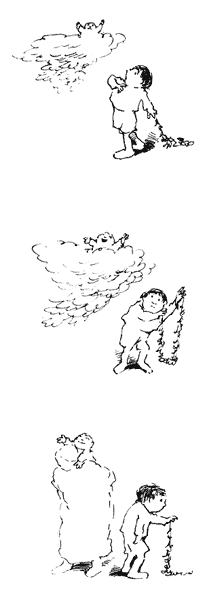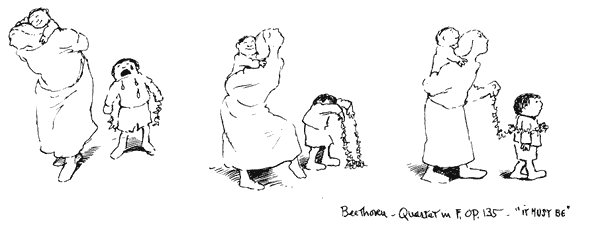This essay, part of a Collection called The Child’s Mind that ran in the April 1978 issue of Harper’s Magazine, was accompanied by It Must Be, a series of illustrations by Maurice Sendak.
listening to small stories
We have all grown used to the idea that we should tell stories to children. We are not so well acquainted with the idea that we should listen to the stories children tell us. When we do hear stories by two-, three-, and four-year-olds, we often fail to understand them or to enjoy their plotless nature. Yet these stories are highly structured and highly meaningful, once we know what to look for.

Here, for example, is the first story told to us by a two-year-old boy:
The monkeys
They went up sky
They fall down
Choo choo train in the sky
The train fall down in the sky
I fell down in the sky
I got on my boat and my legs hurt
Daddy fall down in the sky.

Note that this two-year-old uses the personal pronoun “I” instead of the second-person “he.” Children can tell about their own experiences before they can invent stories. This storyteller hasn’t yet fully distinguished between a story and a personal chronicle. Even by this age, however, he can place the events in the right order. No one falls down out of his sky without having gone up there first. Now here is a story the same boy told us six months later:
A cookie monster hurt his foot
And cookie monster stay up
And fall down again
He get up again
That’s all.
Notice that he is now talking only about an imaginary character. The personal “I” is gone.
How does this child know he has a story to tell? By examining his stories very carefully, we can get an approximate idea. First, he now deals only with fictitious characters. Second, he tells a tale that has a cyclical pattern. The stories go round and round the same theme (in this case, falling down), with much repetition. A child’s account of his personal experience does not have this repetitious, cyclical character.

Here is another story, this one by a two-year-old girl, in which the main focus is not on an action (falling down), but on a person, Batman. She seems to be a progressive two-year-old girl, since she can put together the action characteristics of Batman and the domestic aspects of motherhood.
Batman went away from his Mommy
Mommy said: “Come back, come back.”
He was lost and his Mommy can’t find him
He ran like that [she demonstrates his running] to home
He eat muffins
And he sat on his Mommy’s lap
He fell to sleep
And then him wake up
And it was all still night time
And his Mommy said “go back to bed”
And him did
And then he wake up again
And then the Mommy told him to go back to bed
And he did all night
And then it the morning time
And his Mommy picked him up
And then him have a rest
He ran very hard away from his Mommy like that.
I finished.
The focus on a central theme, to which the child keeps returning, mirrors the organization of earlier spontaneous play. Children between the ages of one and two spend hours putting the same doll or truck through a series of actions. Between two and three, when they begin to tell stories, they continue to put one person (Batman) through a series of actions (running, eating, sleeping), or they permutate one action (falling down) through a series of agents (the monkeys, the train, Daddy). Thus there is an organized grammar of meanings in these stories.
In addition, these children are already using both the past tense and what we call boundary rules. Two of the stories finish with “That’s all” and “I finished.” By his third year, the narrator may well add “Once Upon a Time” (or “One Uponce a Time”) and “Lived happily ever after,” though these markers are used less frequently now that children hear them less often.

In the following tale, a four-year-old boy has taken this art of framing his story to a point approaching satire.
Once upon a time the once upon a time
Ate the once upon a time
Which ate the once upon a time
And then the once upon a time which
Ate the once upon a time ate
The Princess once upon a time with the King
And then the once upon a time died.
Then the end ate the end
The end
Then the end died
Then the end died
Then the end died
Then the end died
And then the end, the end, the end, died
The end with a the end
The end
The end.
There is a literary quality to this story, quite apart from the humor of the unusual use of the marker “Once upon a time.” It has both alliterative effects (“and then the”) and rhyming (“the end, the end”). Even the earlier story of the two-year-old boy has an incredible metaphoric power in the image of the train falling out of the sky. That is about as big a disaster as one can contemplate in the falling business, and it demonstrates the child’s early figurative grasp of the powers with which he deals.
The reader may still be worried about the absence of any real plot in these stories. Until five or six years of age, children do not usually tell us a story with clear-cut stages of conflict and conflict resolution. We tend to get the conflict without the resolution, in a narrative method that is not unlike that of American Indian folktales.
Most earlier work on children’s stories has concentrated on symbolic content. A traditional analysis of the examples I have quoted would examine the meaning of “falling down,” “legs hurt,” “lost,” “eating,” or “dying.”
Such elements cannot carry the whole burden of what is occurring here. In using a grammar, literary effects, story frames and characters, and the past tense, these children are demonstrating a complex intellectual skill that develops markedly between the ages of two and four years. Even though their plots are not the kind we are accustomed to, we should listen to these stories more and learn to enjoy with our children these early
celebrations of fateful experience.
Consider the following relatively plotless masterpiece by a four-year-old boy:
Once upon a time there was a monster named King of the Beasts
And King of the Beasts went out for a walk
He walked for a hundred and two years and he died
His bones said “wake up wake up”
And then his bones died and then his spirit said “wake up wake up” to his
bones
The house became haunted.
And then a person went in and the person got scared away and his brother
bit the body part.
His brother died
And then the other brother died in the same house
And then the same thing happened
And then often the same thing happened, the same thing happened to both of
them again and they were really dreaming that they died
After they woke up they really died
And then the skeleton said “wake up wake up”
And the spirit said “wake up wake up” to the skeleton.
The end.

“[There are] games children must conjure up to combat an awful fact of childhood: the fact of their vulnerability to fear, anger, hate, frustration—all the emotions that are an ordinary part of their lives and that they can perceive only as ungovernable and dangerous forces. To master these forces, children turn to fantasy: that imagined world where disturbing emotional situations are solved to their satisfaction.”—Maurice Sendak, accepting the 1964 Caldecott Medal for his book Where the Wild Things Are


































































































